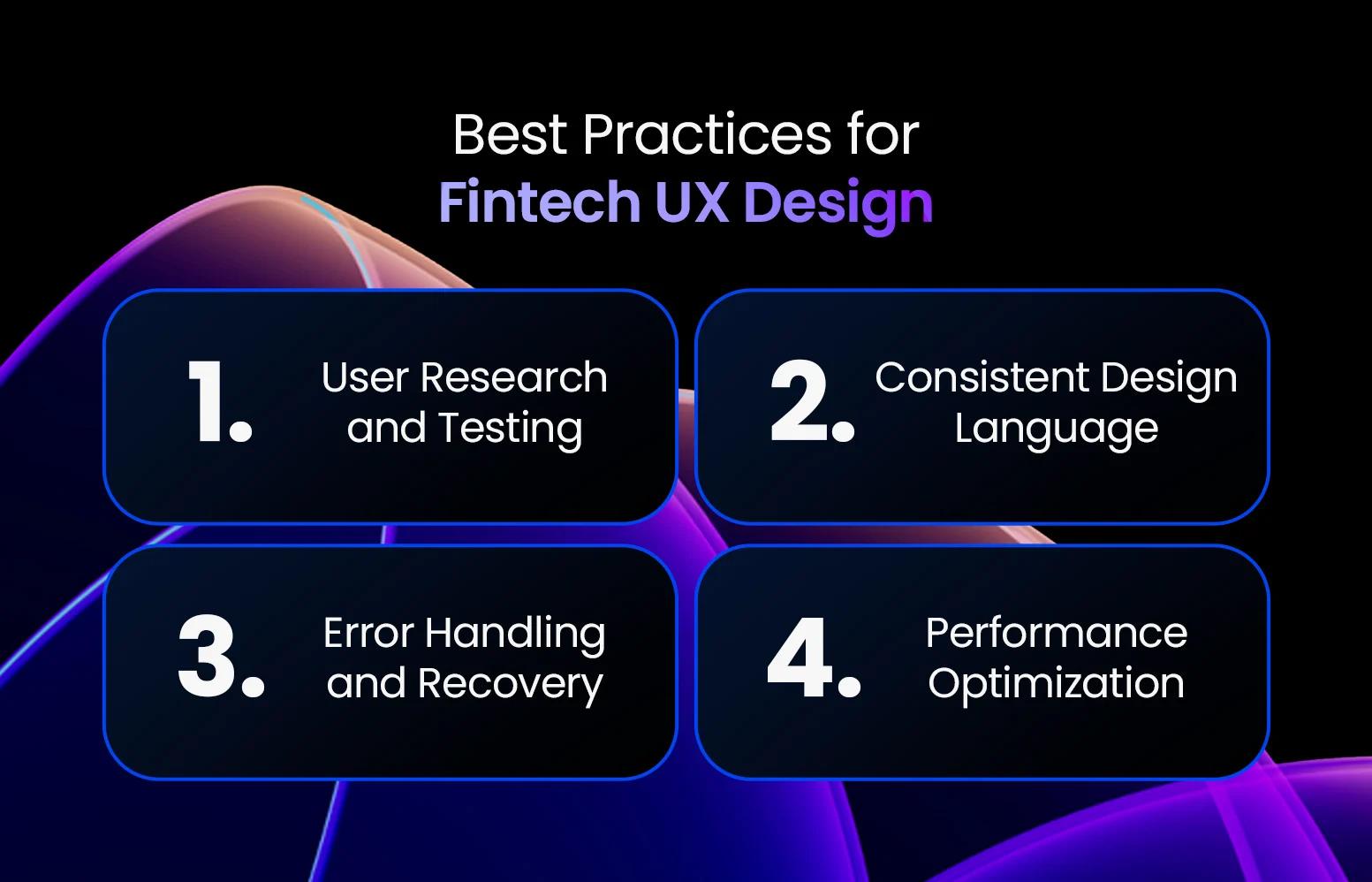Did you know that as much as 73% of users would switch banks for a better user experience?
This telling figure showcases the importance of thoughtful, user-first UX and UI in fintech industry, where trust and feeling of security is paramount.
This article looks into fintech UX design, the best practices, use cases and everything else you need to know.
In brief:
- UX in fintech builds trust by implementing strong security features and transparent data usage policies.
- It's important to simplify user journeys with intuitive interfaces and clear communication.
- Businesses should strive to deliver personalized experiences to meet unique user preferences and behaviors.
- You should design inclusively to make sure there is accessibility for all users, regardless of abilities.

What is Fintech UX Design?
Fintech UX design focuses on creating user experiences that make financial technology easy and enjoyable to use. It involves designing interfaces that help users navigate complex financial tasks with ease.
A seamless user experience in fintech makes sure that users can complete their tasks without frustration. Whether it’s transferring money, checking account balances, or investing, a smooth experience keeps users engaged and satisfied.
UX designers play a key role in this process. They research user needs, create intuitive layouts, and test designs to meet user expectations. By focusing on usability, they make financial apps accessible and efficient for everyone.

4 Key Principles of Fintech UX Design
Financial applications handle sensitive personal and transactional data, making design principles critical to both user satisfaction and regulatory compliance. These four principles form the foundation of effective fintech UX, balancing security requirements with intuitive user experiences that build confidence and drive engagement.
1. Security and Trust
Ensuring data privacy and security stands as a top priority in fintech UX design. Users need to feel confident that their sensitive information remains protected. Implement robust encryption methods and secure authentication processes to safeguard user data.
Building trust through transparency involves clear communication about how user data is collected, stored, and used. Users appreciate knowing that their privacy is respected and that they have control over their information. Display privacy policies and terms of service in an accessible manner.
Balancing security measures with user experience means implementing strong security protocols without complicating the user journey. Avoid excessive security steps that may frustrate users. Instead, integrate seamless security features like biometric authentication, which enhances security while maintaining ease of use.
Consider leveraging specialized product teams for website development so your fintech app meets these high standards. These security-focused design decisions create the foundation of trust that fintech applications require, enabling users to engage confidently with complex financial tasks while maintaining the streamlined experiences they expect from modern digital products.
2. Simplicity and Clarity
Financial products often involve multi-step processes and complex concepts that can overwhelm users. Breaking these down into digestible components while maintaining clarity in language and navigation becomes essential for reducing friction and building user confidence.
- For instance, you can streamline the process of transferring funds by reducing the number of required inputs and providing clear instructions.
- Clear communication and language are vital. Use straightforward, jargon-free language that users can easily understand. Avoid technical terms that might alienate users. Instead, opt for simple explanations and helpful tooltips to guide users through unfamiliar concepts.
- Designing a SaaS navigation menu and user flows helps users find what they need quickly. Design logical pathways that guide users from one task to the next without unnecessary detours. Employ familiar navigation patterns and consistent layouts to create a cohesive experience.
By prioritizing clarity and intuitive flows, fintech applications transform potentially intimidating financial processes into manageable, confidence-building experiences that encourage continued engagement.
3. Personalization
Generic financial experiences fail to address the diverse needs and goals of individual users. Effective personalization leverages data insights to create relevant, timely interactions that feel tailored rather than generic.
- Collect and analyze user data to understand preferences and behaviors. Use this information to provide personalized content, such as tailored financial advice or customized dashboards.Leveraging data for personalized insights and recommendations allows users to make informed decisions.
- Use SaaS solutions page design best practices, including presenting relevant information based on their financial history and goals. For example, suggest investment opportunities that align with their risk tolerance and financial objectives.
- Customizable interfaces and settings empower users to adapt the app to their preferences. Offer options for users to adjust themes, notification preferences, and dashboard layouts. This flexibility enhances user satisfaction by providing a sense of control over their experience.
This personalized approach transforms fintech apps from transactional tools into strategic financial partners that adapt to individual user contexts and objectives.
4. Accessibility
Financial services must serve all users regardless of physical abilities or technical literacy. Designing for accessibility from the outset ensures compliance with standards while expanding your potential user base and improving usability for everyone.
- Consider users with varying levels of vision, hearing, and motor skills. Implement features like screen readers, keyboard navigation, and adjustable text sizes to accommodate different abilities. Adherence to accessibility guidelines, such as the Web Content Accessibility Guidelines (WCAG), ensures that your fintech app meets industry standards.
- Regularly test your app for compliance and make necessary adjustments to improve accessibility. Inclusive design practices involve considering the needs of all users from the outset.
- Avoid retrofitting accessibility features after the fact. Instead, integrate them into the UX design process to create a seamless experience for everyone. This approach not only benefits users with disabilities but also enhances usability for all users.
These inclusive design practices ensure fintech platforms serve the broadest possible audience while meeting both ethical obligations and regulatory requirements.

4 Best Practices for Fintech UX Design
Understanding user needs requires systematic research and continuous validation throughout the design process. These best practices ensure fintech products remain aligned with real user behaviors, preferences, and pain points rather than assumptions or internal biases.
1. User Research and Testing
Conducting user interviews and surveys helps you understand your users' needs, preferences, and pain points. Direct feedback from users provides valuable insights into how they interact with your fintech app, what features they find useful, and where they encounter difficulties. These SaaS website best practices form the foundation for designing a user-centric product.
Usability testing and feedback loops involve observing users as they navigate your app. This process identifies usability issues and areas for improvement. By testing with real users, you can see firsthand how they interact with your app, which helps in pinpointing specific problems that might not be apparent during the design phase.
Iterative design based on user insights makes it possible your app evolves to meet user needs. After gathering feedback, make necessary adjustments and test again. This cycle of testing and refining helps create a product that is not only functional but also intuitive and enjoyable to use.
This research-driven approach ensures design decisions stem from validated user insights rather than assumptions, leading to products that genuinely solve user problems and reduce friction in financial workflows.
2. Consistent Design Language
Establishing a cohesive visual identity creates a unified look and feel for your fintech app. This includes defining color schemes, fonts, and visual elements that reflect your brand. You can take inspiration from the best SaaS product page examples. A consistent visual identity helps users recognize and trust your app, making it easier for them to navigate and use.
Consistent iconography and typography play a significant role in creating a seamless user experience. Icons should be easily recognizable and convey their intended function without confusion. Typography should be legible and consistent across all screens and devices. This consistency helps users quickly understand and interact with your app.
Maintaining design consistency across touchpoints creates an environment in which users have a uniform experience, whether they are using your app on a mobile device, tablet, or desktop. This includes consistent navigation patterns, button styles, and interaction cues. A cohesive design across all platforms builds user confidence and reduces the learning curve. Consistency reduces cognitive load and builds user confidence, allowing them to focus on financial decisions rather than learning new interface patterns with each interaction.
3. Error Handling and Recovery
Clear error messages and guidance help users understand what went wrong and how to fix it. Avoid technical jargon and use simple language to explain the issue. Providing actionable steps to resolve errors reduces user frustration and helps them get back on track quickly.
Graceful error recovery and resolution involve designing your app to handle errors smoothly. This includes saving user progress so they don't lose their work if an error occurs. Offering options to retry or undo actions can also help users recover from mistakes without starting over.
Preventing user frustration and abandonment requires proactive error handling. Anticipate common issues and design your app to minimize their occurrence. For example, validate user input in real time to catch errors before they are submitted. Providing helpful hints and tips during the input process can also prevent errors and improve user satisfaction. You can learn from the best SaaS pricing page examples to enhance error handling.
Thoughtful error handling transforms potential moments of user frustration into opportunities to demonstrate reliability and build trust through graceful recovery mechanisms.
4. Performance Optimization
Minimizing loading times and latency is vital for a smooth user experience. Users expect fast and responsive apps, especially when dealing with financial transactions. Optimize your app's performance by reducing the size of assets, compressing images, and using efficient coding practices.
Efficient data retrieval and caching improve app performance by reducing the time it takes to load data. Implement caching strategies to store frequently accessed data locally, reducing the need for repeated server requests. This not only speeds up the app but also reduces the load on your servers.
Smooth animations and transitions enhance the user experience by making interactions feel more natural and engaging. Use animations to provide visual feedback and guide users through tasks. However, make sure that animations are subtle and do not hinder performance. Well-designed transitions can make your app feel more polished and professional, contributing to a positive user experience.
Performance optimization directly impacts user satisfaction and conversion rates, with even small delays potentially causing users to abandon critical financial transactions or doubt platform reliability.

Best Practices of Fintech UX Design
5 Latest UX Design Trends in Fintech
Emerging technologies and evolving user expectations continuously reshape fintech UX design. These five trends represent significant shifts in how users interact with financial platforms and what they expect from digital financial services. Staying ahead of UX trends is crucial for maintaining a competitive edge.
1. Artificial Intelligence
Personalized financial advice and recommendations are now possible with AI. By analyzing user data, AI can offer tailored advice that fits individual financial situations. This might include investment suggestions, budgeting tips, or alerts about unusual spending patterns.
Predictive analytics for proactive support helps users stay ahead of potential issues. AI can predict future financial needs based on past behavior and provide timely recommendations. For example, if the system detects that a user is likely to run out of funds before their next paycheck, it can suggest ways to manage expenses.
Fraud detection and risk assessment are enhanced by AI. Machine learning algorithms can analyze transaction patterns to identify suspicious activity. This allows for quicker detection and response to potential fraud, protecting users' financial information.
AI transforms fintech from reactive tools that execute commands into proactive partners that anticipate needs and protect users through intelligent pattern recognition.
2. Mobile-First Design
Optimizing for smaller screens and touch interactions has become a priority. Users expect to manage their finances on the go, and mobile devices are their primary tools. Designing for smaller screens means creating interfaces that are easy to navigate with a finger tap. Buttons should be large enough to press without error. You can check mobile navigation menu designs as they should be simple and straightforward.
Responsive layouts and adaptive interfaces ensure that your app looks and functions well on any device. Whether users access your app on a smartphone, tablet, or desktop, the experience should be seamless. This involves using flexible grids and layouts that adjust to different screen sizes and orientations.
Seamless cross-device experiences are key. Users might start a task on their phone and finish it on their laptop. Ensuring that their progress is saved and accessible across devices enhances usability. This requires robust backend systems that sync data in real time.
Mobile-first thinking acknowledges that smartphones have become the primary interface for financial management, requiring designs that prioritize touch interactions and on-the-go accessibility.
3. Gamification
Engaging users through game-like elements can make financial tasks more enjoyable. Gamification involves integrating features like points, badges, and leaderboards to motivate users. For example, you can reward users for completing tasks such as saving money or paying bills on time.
Rewards, achievements, and challenges keep users coming back. Offering incentives for reaching financial goals can encourage positive behaviors. For instance, a savings app might offer virtual badges for hitting savings milestones, making the process of saving money feel more rewarding.
Encouraging positive financial behaviors through gamification can lead to better financial habits. By setting up challenges like "save $100 this month" or "reduce spending by 10%", you can help users stay engaged and motivated to improve their financial health.
These game-like elements leverage behavioral psychology to transform abstract financial goals into tangible achievements, making financial management feel less like a chore and more like progress toward meaningful objectives.
4. Voice User Interfaces
Integrating voice assistants for hands-free interactions is becoming more common. Voice user interfaces (VUIs) allow users to perform tasks using voice commands, which can be especially useful for quick actions like checking account balances or transferring money.
Natural language processing for financial queries makes interactions more intuitive. Users can ask questions in plain language, such as "How much did I spend on groceries last month?" and receive accurate responses. This technology simplifies complex queries and makes financial information more accessible.
The accessibility benefits of voice interfaces are significant. VUIs can help users with disabilities navigate financial apps more easily. For example, visually impaired users can rely on voice commands to perform tasks without needing to see the screen.
Voice interfaces represent a fundamental shift in how users access financial information, prioritizing natural conversation over visual navigation and expanding accessibility for diverse user needs.
5. Biometric Authentication
Enhancing security with biometric authentication is a growing trend. Biometric methods like fingerprint scanning, facial recognition, and voice recognition provide secure and convenient ways for users to access their accounts. These methods reduce the reliance on passwords, which can be forgotten or stolen.
Implementing biometric authentication improves user experience by making login processes faster and more secure. Users can access their accounts with a simple touch or glance, reducing friction and enhancing security.
Biometric data is unique to each user, making it difficult for unauthorized individuals to gain access. This added layer of security helps build trust and confidence in your fintech app, encouraging more users to adopt and rely on your services.
Biometric authentication addresses the fundamental tension between security and convenience, offering protection that strengthens rather than complicates the user experience.
3 Most Common Challenges in Designing for Fintech
Fintech designers face unique constraints that distinguish financial UX from other digital product categories. These three challenges require careful navigation to create products that satisfy both user needs and industry requirements.
Balancing Simplicity and Functionality
Financial applications must handle inherently complex processes involving multiple steps, data inputs, and decision points. The challenge lies in presenting this complexity in ways that feel manageable rather than overwhelming. Streamlining complex financial processes requires thoughtful design. Financial apps often involve intricate tasks like fund transfers, investment management, and loan applications. Simplifying these processes without losing functionality is key.
Break down tasks into smaller, manageable steps. Use clear, concise instructions to guide users through each step, reducing the cognitive load.
Prioritizing essential features and information helps users focus on what matters most. Effective simplification strategies reduce cognitive load without removing essential functionality or transparency:
- Identify the core functionalities your users need and make them easily accessible. Avoid overwhelming users with too many options.
- Highlight critical actions and information on the main screens, and use secondary screens for less frequently used features.
These techniques allow fintech products to maintain full functionality while presenting users with only the information and options they need at each moment in their journey. Progressive disclosure and contextual help enhance user experience by revealing information and options as needed. This approach prevents users from feeling overwhelmed by too much information at once.
Provide additional details and options only when users need them. Use tooltips, pop-ups, and inline help to offer guidance without cluttering the interface.
Regulatory Compliance
Financial services operate within strict regulatory frameworks designed to protect consumers and prevent fraud. These requirements often conflict with user experience best practices, creating tension between legal obligations and usability. Adhering to financial regulations and guidelines is non-negotiable in fintech. Regulations vary by region and can include requirements for data protection, anti-money laundering (AML), and know your customer (KYC) protocols.
Compliance integration requires strategic design that makes regulatory requirements feel natural rather than burdensome:
- See to it that your app complies with these regulations to avoid legal issues. Regularly update your app to reflect changes in regulations. Incorporating necessary disclosures and consent ensures transparency and builds trust.
- Clearly communicate how user data will be used, stored, and shared. Provide easy-to-understand consent forms and privacy policies. Make sure users can easily access and review these documents at any time.
- Balancing compliance with user experience means integrating regulatory requirements without compromising usability. Design forms and processes that meet regulatory standards while remaining user-friendly. For example, streamline KYC processes by allowing users to upload documents directly through the app. Use automation to verify information quickly and accurately, reducing the burden on users and future-proofing your website.
By embedding compliance seamlessly into the user experience, fintech products can meet regulatory standards without sacrificing the fluid, intuitive interactions users expect from modern digital services.
User Onboarding and Education
First impressions determine whether users commit to a new financial platform or abandon it for simpler alternatives. Effective onboarding must balance thorough education with rapid value delivery. Simplifying account setup and verification is crucial for a smooth onboarding experience. Lengthy and complicated setup processes can deter users.
Strategic onboarding design accelerates user understanding while maintaining momentum:
- Use clear, step-by-step instructions to guide users through account creation. Minimize the number of required fields and allow users to complete the process in stages if necessary.
- Guiding users through unfamiliar concepts helps them understand and use your app effectively. Financial apps often involve complex terms and processes. Use plain language and avoid jargon. Provide explanations and examples to clarify concepts.
- Interactive tutorials and walkthroughs can help users get acquainted with your app's features. You can also explore the best multi-step forms to enhance your onboarding process.
- Contextual help and educational resources support users as they navigate your app. Offer in-app help through tooltips, FAQs, and chat support. Create a knowledge base with articles and videos that explain common tasks and features. Regularly update these resources to address new features and user feedback.
These onboarding strategies transform the traditionally intimidating experience of adopting new financial tools into guided journeys that build user confidence from the first interaction.
Use Cases and Case Studies for Fintech in UX
Fintech apps like Robinhood simplify onboarding by using minimal data entry and interactive tutorials to guide new users. This reduces friction and increases sign-ups by creating a seamless entry point for novice investors.
Platforms like Mint use advanced analytics to deliver tailored financial insights, such as spending trends and budgeting recommendations. This enhances user engagement by making the app relevant to individual financial goals.
Apps like PayPal and Venmo prioritize user-friendly payment flows with features like one-tap payments, real-time notifications, and social integration, making transactions effortless.
Revolut revolutionized global banking by incorporating responsive design and gamified features like savings challenges and rewards. This led to a significant increase in daily active users, demonstrating how innovative UX can drive customer retention.
User Research Methods for Fintech UX
Traditional UX research methods require adaptation for fintech contexts, where sensitive data, regulatory constraints, and complex user behaviors create unique challenges. Effective user research in UX combines traditional methods with digital insights. Usability testing allows teams to observe how users interact with prototypes in order to identify uder pain points early.
- Surveys and interviews provide direct feedback on user expectations and challenges, while heatmaps and click-tracking tools reveal behavior patterns on app interfaces.
- Fintech-specific methods like diary studies help teams understand users’ daily financial routines.
- Additionally, incorporating A/B testing helps data-backed decisions for UX improvements.
Combining these methods creates a comprehensive understanding of user needs within the unique constraints and opportunities of financial contexts.
Our Take on UX Design For Fintech
Fintech UX requires a careful balance between usability and trust-building.
As web design experts, we believe simplicity, clarity and security are critical in guiding users through complex financial processes. Effective fintech UX prioritizes clarity in communication, through both intuitive layouts or visual cues, to make finance-related tasks less intimidating. Security should not only be robust but its existence should also visible to users to create a sense of safety without overwhelming them. Personalization and accessibility further enhance engagement to ensure fintech platforms cater to diverse audiences.

Is Fintech UX Design Worth the Investment?
Webstacks approaches fintech UX through the lens of composable architecture and strategic design systems, recognizing that financial platforms require both immediate usability and long-term scalability.
Investing in UX design offers several benefits that can transform your financial app. First, a well-designed user experience attracts and retains customers. When users find your app easy to navigate and intuitive, they are more likely to continue using it and recommend it to others. This leads to higher customer acquisition rates and improved retention.
A strong UX design, applicable to other industries as well, like medtech, also provides a competitive advantage. In a crowded market, a seamless and enjoyable user experience sets your app apart from others. Users will choose your app over competitors if it offers a smoother, more efficient experience. This differentiation can be a key factor in gaining market share.
Investing in fintech UX design ultimately leads to a better product that meets user needs, stands out in the market, and operates more efficiently.




